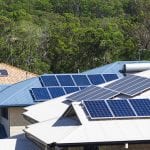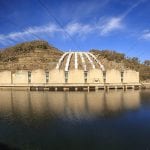Around The Web
China’s carbon emissions rise on lasting construction boom
Windlab declares “force majeure” on Kennedy wind, solar battery project
 Windlab says connection delays, floods and EPC problems causes "force majeure" on world-first wind, solar, battery park, and warns new connection rules are pushing up costs of renewables.
Windlab says connection delays, floods and EPC problems causes "force majeure" on world-first wind, solar, battery park, and warns new connection rules are pushing up costs of renewables.
The post Windlab declares “force majeure” on Kennedy wind, solar battery project appeared first on RenewEconomy.
Second US-N. Korea summit ends early with no agreement
Outdoor Photographer of the Year 2018 – in pictures
Our selection of winning and shortlisted photographs from the 2018 competition
Continue reading...The butterfly effect: wings in extreme close-up – in pictures
In his new series Metamorphosis, photographer Jake Mosher composes artworks using hundreds of exposures of highly magnified butterflies’ and moths’ wings
Continue reading...Australia's annual emissions continue to rise, driven by LNG production
Emissions for the year to September 2018 up 0.9% as Morrison government attempts a policy pivot on climate
Emissions in Australia are continuing to rise, with the latest increases driven predominantly by an increase in liquefied natural gas production in Western Australia.
Emissions for the year to September 2018 went up 0.9% on the previous year, according to the latest inventory, primarily due to a 19.7% increase in LNG exports, but there were also increases in stationary energy, transport, fugitives, industrial processes and waste sectors.
Continue reading...Hunting for space rocks in Antarctica
The home jungle: how to live happily with the 5,000 other species in your house
Biologist Rob Dunn is the David Attenborough of the domestic sphere, uncovering everything from microbes in the shower to spiders in the basement. He goes on safari in the satisfyingly dusty corners of one Copenhagen home
The good news is that I will never be home alone again. The bad news – well, it’s not in fact bad news, but it is slightly unsettling – is that I share my home with at least 5,000 other species: wasps, flies, spiders, silverfish and an exotic bunch of wild bacteria.
All that information is apparently contained in a patch of grey dust I have just swabbed with my right index finger from a door frame in my living room. It’s like a DNA test of my house, says Rob Dunn, a 43-year-old American biologist who has come to my house in Copenhagen to hunt microbial life. He carries no lab gear and his blue crewneck jumper and striped Oxford shirt are hardly the combat suit of an exterminator. But with every discovery we make, with every spider we find lurking in the corner or each swab of dust, he displays an almost childlike sense of excitement. He swears and smiles, even whoops with delight: “This dust sample contains bacteria, your body microbes, your wife’s body microbes, your child’s body microbes. If you smoke weed we would find marijuana DNA in there. Everything is visible, but it’s also present in every breath. Every time you inhale, you inhale that story of your home.”
Continue reading...Victoria regulator lifts fixed rooftop solar export tariffs, slashes peak rate
 Victoria regulator ups solar tariffs for minimum "single rate", but slashes the peak rate for solar exports by more than half.
Victoria regulator ups solar tariffs for minimum "single rate", but slashes the peak rate for solar exports by more than half.
The post Victoria regulator lifts fixed rooftop solar export tariffs, slashes peak rate appeared first on RenewEconomy.
Burning issue: are waste-to-energy plants a good idea?
Victoria’s first waste-to-energy project is going ahead but these projects threaten recycling and could pose health concerns
It’s the controversial scheme that’s attracting attention across the nation but as more waste-to-energy facilities get the green light, critics fear the opportunity to improve Australia’s recycling industry is going up in smoke.
Waste-to-energy, also called bioenergy, has been used in Europe, east Asia and the United States for decades to destroy garbage that would otherwise go to landfill. The trash is burned as feedstock at high temperatures to create fuel, gas or steam that drives a turbine and churns out electricity.
Continue reading...Redflow says on track to cut flow battery production costs by one-third
 ASX-listed Australian flow battery maker says it can boost production of its ZMB2 batteries to 30MWh a year, and cut costs by 30% by 2020.
ASX-listed Australian flow battery maker says it can boost production of its ZMB2 batteries to 30MWh a year, and cut costs by 30% by 2020.
The post Redflow says on track to cut flow battery production costs by one-third appeared first on RenewEconomy.
CP Daily: Wednesday February 27, 2018
Webspinners: New order of insects sets up home in UK
UK Antarctic meteorite hunt bags large haul
Energy Insiders Podcast: Simec Energy and ScoMo’s big hydro pump
 Simec Energy’s Marc Barrington on the Gupta company’s plans for clean energy, the PUB battery at Port Augusta, and trying to make sense of the Coalition energy policy.
Simec Energy’s Marc Barrington on the Gupta company’s plans for clean energy, the PUB battery at Port Augusta, and trying to make sense of the Coalition energy policy.
The post Energy Insiders Podcast: Simec Energy and ScoMo’s big hydro pump appeared first on RenewEconomy.
Oregon LCFS upheld again as another court dismisses challenge
France’s Macron floats linking domestic CO2 tax to oil prices to allay unrest
NSW Labor aims for “at least” 50% renewables by 2030
 NSW Labor says will target at least 50% renewables by 2030, and 100% of state government electricity needs by 2025.
NSW Labor says will target at least 50% renewables by 2030, and 100% of state government electricity needs by 2025.
The post NSW Labor aims for “at least” 50% renewables by 2030 appeared first on RenewEconomy.



